In support of their development and growth across Canada, Lindt recognized the need for improved business intelligence and data-driven decision-making and became an IBM Cognos customer over 20 years ago. Although Lindt’s usage of Cognos has significantly evolved over the years, they have primarily focused on developing analytics solutions for their sales and marketing functions. After a recent review of their use of analytics throughout the organization, it was clear that the supply chain team had been underserviced. John Walter, IT Director at Lindt Canada says, “the supply chain team was using legacy reporting tools that required them to gather data from various sources, drop it into a big Excel spreadsheet and manually slice and dice it to produce some form of analytics.”
The supply chain team had ultimately created their own data warehouse in a massive Excel file, filled with complex calculations and lookups. In addition to the time and effort involved in maintaining such a file, this siloed approach to data management resulted in a number of problems, including the inability to easily share and visualize insight across the organization, minimal integration with other data sources, limited data quality and governance controls and a lack of automation.
Lindt saw an opportunity to collaborate with key stakeholders on the supply chain team to identify key priorities and then migrate some of their solutions out of the legacy applications and move them to a modern analytics tool set. This would provide the supply chain team with their own dashboards and analytics and their own data sets while leveraging the same Business Intelligence (BI) platform used by the rest of the organization.




